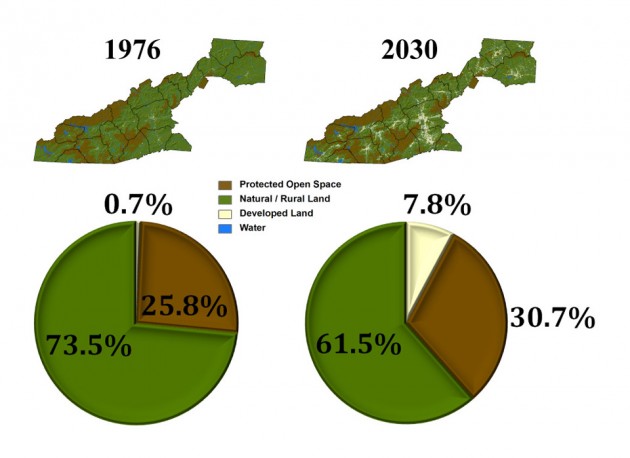Charlotte, N.C. – From 1976 to 2006, land development in the North Carolina mountains increased 568 percent, from 34,348 acres to 229,422 acres, and is expected to increase another 63 percent by 2030 (an additional 145,374 acres), according to a study just released by researchers at the Renaissance Computing Institute (RENCI) at UNC Charlotte.
Population, meanwhile, increased only 42 percent between 1976 and 2006 and is projected to increase another 25 percent by 2030. The result? An increase in the average number of developed acres per person, or the “development footprint,” from 0.06 acres per person in 1976 to 0.30 acres in 2006, and a projected 0.39 acres per person by 2030.
How has rapid urban growth and land development changed western North Carolina’s natural landscape since 1976? What challenges will the region face over the next 20 years in accommodating growth and protecting its abundant natural resources and great biodiversity? Researchers at UNC Charlotte’s Center for Applied Geographic Information Science (CAGIS), a research partner with RENCI at UNC Charlotte, are collaborating with RENCI at UNC Asheville to address these and other urbanization issues. The study was made possible through funding from the City of Asheville, the U.S. Forest Service and RENCI’s home office in Chapel Hill.
Using historical satellite imagery and population data and projections, the researchers have developed an Urban Growth Model that generates statistical and visual representations of likely trends in developed land area. Satellite image analysis reveals how the landscape has changed from 1976 through 2006. The Urban Growth Model combines the satellite image-based maps of development with population trends and offers forecasts of future development in the region through 2030. The 19-county western North Carolina study builds upon similar studies by RENCI at UNC Charlotte, including the 2009 four-county analysis of Asheville and surrounding area and the 2007 original study of development in the Southern Piedmont / Greater Charlotte Metropolitan region.
By examining historical and forecast patterns of urbanization, RENCI researchers hope to assist policy makers, planners, and land conservationists in developing tools to understand and plan for rapid urban growth. James Fox, the director of RENCI at UNC Asheville and the school’s National Environmental Modeling and Analysis Center (NEMAC), said local stakeholders already are showing an interest in the study’s results. “This versatile study from RENCI at UNC Charlotte has allowed us to gain maximum benefit from the limited resources available in today’s economic climate. Being able to use this study at a variety of scales has proved invaluable.”
Fox added that UNC Asheville has used the study’s results in conjunction with the City of Asheville, Buncombe County, the local Land of Sky Council of Governments, and the U.S. Forest Service.
Analysis of historical satellite imagery indicates that between 1976 and 2006, development in the 19-county region occurred at an average rate of 17 acres per day, outpacing population growth nearly 14-to-1. The Urban Growth Model forecasts that by 2030, the average rate of development in the region will be 16.3 acres per day, and development will continue to outpace population growth 2.5-to-1.
The results also show great variation in forecast gains in development among the counties in the region. Alleghany, Ashe, and Madison counties are expected to experience the highest rates of forecast development, with Madison County experiencing the greatest percent increase – 109 percent – in developed acres, Alleghany County experiencing a 102 percent increase, and Ashe County a 103 percent increase. Buncombe and Henderson Counties, the two most populated counties in the region, are expected to contribute roughly 17 percent and 13 percent, respectively, of total forecast gains for the region.
Looking forward regionally, the model predicts that by 2030, when the population is expected to approach 1 million, an additional 145,374 acres of land will be developed, the equivalent of an area roughly the size of Alleghany County (147,333 acres), or nearly six times the acres within Asheville’s city limits.
The full research report is available at http://ui.uncc.edu/content/nearly-570-increase-development-western-nc-mountains-1976.
###
For more information about the model, or to schedule an interview with the study’s authors, contact Vicki Bott at (704) 678-2762 or vabott@uncc.edu. For more information about plans for incorporating the study’s results into ongoing work in the region, contact Jim Fox at (825) 301-2075 or jfox@unca.edu.



